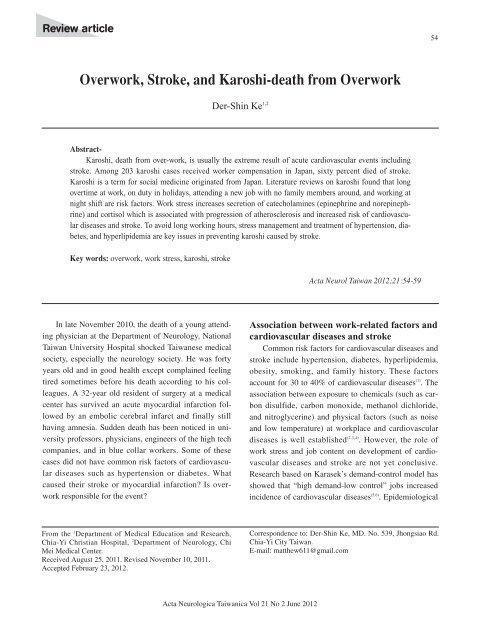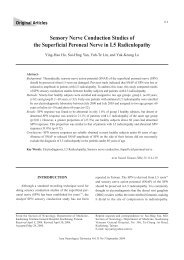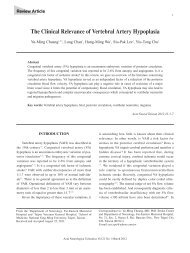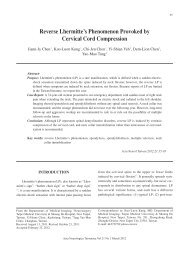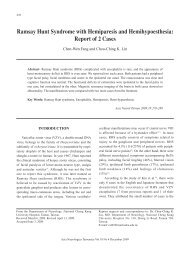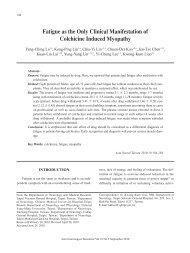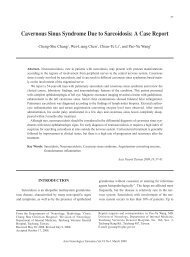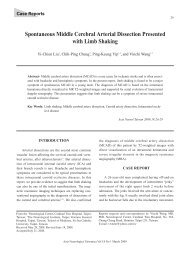Overwork, Stroke, and Karoshi-death from Overwork - Ant
Overwork, Stroke, and Karoshi-death from Overwork - Ant
Overwork, Stroke, and Karoshi-death from Overwork - Ant
You also want an ePaper? Increase the reach of your titles
YUMPU automatically turns print PDFs into web optimized ePapers that Google loves.
Review article<br />
<strong>Overwork</strong>, <strong>Stroke</strong>, <strong>and</strong> <strong>Karoshi</strong>-<strong>death</strong> <strong>from</strong> <strong>Overwork</strong><br />
From the 1 Department of Medical Education <strong>and</strong> Research,<br />
Chia-Yi Christian Hospital, 2 Department of Neurology, Chi<br />
Mei Medical Center.<br />
Received August 25, 2011. Revised November 10, 2011.<br />
Accepted February 23, 2012.<br />
Der-Shin Ke 1,2<br />
Abstract-<br />
<strong>Karoshi</strong>, <strong>death</strong> <strong>from</strong> over-work, is usually the extreme result of acute cardiovascular events including<br />
stroke. Among 203 karoshi cases received worker compensation in Japan, sixty percent died of stroke.<br />
<strong>Karoshi</strong> is a term for social medicine originated <strong>from</strong> Japan. Literature reviews on karoshi found that long<br />
overtime at work, on duty in holidays, attending a new job with no family members around, <strong>and</strong> working at<br />
night shift are risk factors. Work stress increases secretion of catecholamines (epinephrine <strong>and</strong> norepinephrine)<br />
<strong>and</strong> cortisol which is associated with progression of atherosclerosis <strong>and</strong> increased risk of cardiovascular<br />
diseases <strong>and</strong> stroke. To avoid long working hours, stress management <strong>and</strong> treatment of hypertension, diabetes,<br />
<strong>and</strong> hyperlipidemia are key issues in preventing karoshi caused by stroke.<br />
Key words: overwork, work stress, karoshi, stroke<br />
In late November 2010, the <strong>death</strong> of a young attending<br />
physician at the Department of Neurology, National<br />
Taiwan University Hospital shocked Taiwanese medical<br />
society, especially the neurology society. He was forty<br />
years old <strong>and</strong> in good health except complained feeling<br />
tired sometimes before his <strong>death</strong> according to his colleagues.<br />
A 32-year old resident of surgery at a medical<br />
center has survived an acute myocardial infarction followed<br />
by an embolic cerebral infarct <strong>and</strong> finally still<br />
having amnesia. Sudden <strong>death</strong> has been noticed in university<br />
professors, physicians, engineers of the high tech<br />
companies, <strong>and</strong> in blue collar workers. Some of these<br />
cases did not have common risk factors of cardiovascular<br />
diseases such as hypertension or diabetes. What<br />
caused their stroke or myocardial infarction? Is overwork<br />
responsible for the event?<br />
Acta Neurologica Taiwanica Vol 21 No 2 June 2012<br />
Association between work-related factors <strong>and</strong><br />
cardiovascular diseases <strong>and</strong> stroke<br />
Common risk factors for cardiovascular diseases <strong>and</strong><br />
stroke include hypertension, diabetes, hyperlipidemia,<br />
obesity, smoking, <strong>and</strong> family history. These factors<br />
account for 30 to 40% of cardiovascular diseases (1) . The<br />
association between exposure to chemicals (such as carbon<br />
disulfide, carbon monoxide, methanol dichloride,<br />
<strong>and</strong> nitroglycerine) <strong>and</strong> physical factors (such as noise<br />
<strong>and</strong> low temperature) at workplace <strong>and</strong> cardiovascular<br />
diseases is well established (2,3,4) . However, the role of<br />
work stress <strong>and</strong> job content on development of cardiovascular<br />
diseases <strong>and</strong> stroke are not yet conclusive.<br />
Research based on Karasek’s dem<strong>and</strong>-control model has<br />
showed that “high dem<strong>and</strong>-low control” jobs increased<br />
incidence of cardiovascular diseases (5,6) . Epidemiological<br />
Correspondence to: Der-Shin Ke, MD. No. 539, Jhongsiao Rd.<br />
Chia-Yi City Taiwan.<br />
E-mail: matthew611@gmail.com<br />
54<br />
Acta Neurol Taiwan 2012;21:54-5921:1-
studies in the United States <strong>and</strong> Japan found positive<br />
association between over-time work, shift work, <strong>and</strong><br />
long-travelling time to work <strong>and</strong> cardiovascular diseases<br />
(2,7,8,9) . Studies in Europe found that low reward jobs,<br />
shift work, <strong>and</strong> working at night increased risk of cardiovascular<br />
diseases (10,11,12) .<br />
<strong>Karoshi</strong>, <strong>death</strong> <strong>from</strong> overwork, is a social medicine<br />
term first appeared in Japan in late 1970 (13,14) . The first<br />
reported case of karoshi was in 1969 with a stroke <strong>death</strong><br />
of a 29-year-old male worker in the shipping department<br />
of Japan’s largest newspaper company (13) . It was not until<br />
the later part of the 1980s when several business executives<br />
who were in their prime years suddenly died without<br />
any previous sign of illness. This new phenomenon<br />
attracted media’s attention in Japan, <strong>and</strong> was quickly<br />
labeled karoshi, denoting a novel <strong>and</strong> serious menace for<br />
people in the work force (13) . <strong>Karoshi</strong> is occupational sudden<br />
<strong>death</strong>. The major medical causes of karoshi <strong>death</strong>s<br />
are heart attack <strong>and</strong> stroke due to stress (13) . There are<br />
Taiwanese social scientists retrospectively reviewed the<br />
developmental process of Japanese industry <strong>and</strong> enterprise<br />
(15,16,17) . They tried to explore factors associated with<br />
karoshi events <strong>from</strong> social science viewpoint. They have<br />
found two major factors associated with karoshi: 1. long<br />
working hours; 2. too much work stress. They also found<br />
that workers working with irregular duty hours, taking<br />
new jobs without family members around, working at<br />
night, <strong>and</strong> piecemeal jobs are associated with increased<br />
risk of karoshi. Furthermore, business <strong>and</strong> union leaders<br />
did not pay attention to the impact of work stress on<br />
Table 1. Major medical causes of <strong>death</strong> <strong>and</strong> symptoms <strong>and</strong> signs in karoshi<br />
Acta Neurologica Taiwanica Vol 21 No 2 June 2012<br />
55<br />
karoshi, <strong>and</strong> this ignorance has contributed to the<br />
increase of karoshi in Japan.<br />
Responding to the increased attention <strong>and</strong> awareness<br />
to karoshi, the Japanese Ministry of Labor began to publish<br />
statistics on karoshi in 1987 (13) . Many companies,<br />
such as Toyota, have working hour policy to limit overtime<br />
work <strong>and</strong> stressed the importance of rest <strong>and</strong> urging<br />
workers to go home. Moreover, governments, including<br />
Japan <strong>and</strong> Taiwan, have faced increasing pressure <strong>and</strong><br />
finally set legal criteria of karoshi for worker compensation.<br />
Taiwanese government passed the guideline for<br />
establishing occupational cardiovascular <strong>and</strong> cerebrovascular<br />
diseases in 1991 <strong>and</strong> revised in 2004 <strong>and</strong> in 2010.<br />
Table 1 described major medical causes of <strong>death</strong> <strong>and</strong><br />
symptoms <strong>and</strong> signs of karoshi (13,18) . Most frequent medical<br />
causes of <strong>death</strong> are acute heart failure <strong>and</strong> subarachnoid<br />
hemorrhage. People under overwork stress may<br />
present with no obvious symptoms <strong>and</strong> signs of heart<br />
<strong>and</strong>/or brain problems but with depression <strong>and</strong>/or<br />
burnout syndrome (18) . Death <strong>and</strong> suicide due to overwork<br />
has been reported as new occupational threats to<br />
Japanese physicians (18) .<br />
Stress hormones in health <strong>and</strong> illness: the role<br />
of work<br />
Two neuroendocrine systems would be of specific<br />
interest in the study of health impact <strong>from</strong> stress (19) . The<br />
sympathetic adrenomedullary system secrets two catecholamines,<br />
epinephrine <strong>and</strong> norepinephrine, <strong>and</strong> the<br />
hypothalamic pituitary adrenocortical system secrets<br />
Major medical causes of <strong>death</strong> (%) (13) SAH*(18.4%)<br />
Cerebral hemorrhage (17.2%)<br />
Cerebral infarction (6.8%)<br />
Myocardial infarction (9.8%)<br />
Heart failure (18.7%)<br />
Other causes (29.1%)<br />
Pre-event condition (18) Common symptoms <strong>and</strong> signs<br />
Burnout symptoms Easy fatigue, forgetful, tight neck <strong>and</strong> shoulder, headache, myalgia, chest tightness,<br />
body weight change.<br />
Depression Poor concentration, feels blue easily, insomnia, suicide idea or attempt<br />
*SAHsubarachnoid hemorrhage
56<br />
cortisol. These hormones have often been used as stress<br />
indicators because they can be measured in blood <strong>and</strong><br />
urine. In response to stress, epinephrine <strong>and</strong> norepinephrine<br />
are rapidly secreted into blood stream with pronounced<br />
effect on the cardiovascular system <strong>and</strong> caused<br />
release of energy, glucose <strong>and</strong> free fatty acids. The stress<br />
response could be life saving for human especially while<br />
facing emergency. When an individual encounters stressful<br />
life events (stressors), he or she uses self-coping<br />
mechanisms to resolve the stress. The response to a<br />
stressful event may vary depending upon the physiological<br />
<strong>and</strong> psychological state of the person. If failed to<br />
achieve complete resolution, a prolonged stress stimulus<br />
or residual stress can cause psychophysiological<br />
responses (i.e., stress response) which may result in<br />
increased vulnerability to or directly cause organic diseases<br />
(20,21) . The physiological response of residual stress<br />
may increase sympathetic nerve activity <strong>and</strong> elevate<br />
blood catecholamine levels which may be detrimental to<br />
health over a long period. Therefore, long-term stress<br />
could result in sustained higher serum level of catecholamines<br />
<strong>and</strong> elevated blood pressure. Folkow (22) has<br />
proposed a model in which elevated blood pressure<br />
responses could lead to thickening of artery walls <strong>and</strong><br />
narrowing of the blood vessels, thus increasing peripheral<br />
resistance in the cardiovascular system. The catecholamines<br />
also contribute to elevated blood lipid levels,<br />
increased blood clotting, <strong>and</strong> atherosclerosis (19) .<br />
Epinephrine <strong>and</strong> norepinephrine are associated with<br />
hypertension, myocardial infarction <strong>and</strong> stroke. On the<br />
other h<strong>and</strong>, cortisol affects cell metabolism <strong>and</strong> fat distribution,<br />
<strong>and</strong> has been linked to cardiovascular disease,<br />
type 2 diabetes, reduced immune function <strong>and</strong> impaired<br />
cognition (19) . Lundberg <strong>and</strong> Hellstrom (23) found that<br />
women regularly worked more than 50 hours a week had<br />
double cortisol levels compared with women with a<br />
more moderate workload.<br />
Psychosocial work environment <strong>and</strong> work<br />
stress<br />
Over the past few decades, stress has come to be recognized<br />
as one of the most pervasive <strong>and</strong> potent health<br />
hazards in the work environment. Occupational stress<br />
Acta Neurologica Taiwanica Vol 21 No 2 June 2012<br />
Figure 1. A three-dimensional model for psychosocial work environment<br />
(adapted <strong>from</strong> Karasek <strong>and</strong> Theorell 24 )<br />
refers to negative environmental factors or stressors (e.g.<br />
work overload, role conflict/ambiguity, poor working<br />
conditions) associated with a particular job or workplace<br />
(21) . Karasek <strong>and</strong> Theorell (24) present a three-dimensional<br />
model (Figure 1) integrating three psychosocial aspects<br />
of the work environment <strong>and</strong> their association with<br />
worker’s health. These three aspects include job dem<strong>and</strong>,<br />
decision latitude (job control), <strong>and</strong> social support at<br />
work. The underlying theory of the model is that stress is<br />
the result of a lack of balance between three work factors:<br />
work dem<strong>and</strong>s, work supports, <strong>and</strong> work constraints<br />
such as monotonous tasks that limit workers to<br />
have control on their performances. These three factors<br />
encompass almost all aspects of the workplace that<br />
workers encounter, both physically <strong>and</strong> psychologically.<br />
Job decision latitude is the worker’s potential control<br />
over job-related decision making; this involves control<br />
over the use of skills, time allocation, <strong>and</strong> organizational<br />
decisions. Job dem<strong>and</strong>s refer to the need to do jobs in a<br />
dem<strong>and</strong>ing way such as doing jobs very fast or very<br />
hard, or having a disproportionate amount of work to be<br />
done within a limited time frame. They found that the<br />
primary work-related risk factor appears to be a lack of<br />
control over how one meets the job’s dem<strong>and</strong>s <strong>and</strong> how<br />
one uses one’s skills; elevation of risk with a dem<strong>and</strong>ing<br />
job, in many cases, appears only when these dem<strong>and</strong>s<br />
occur in interaction with low control on the job (24) .<br />
The most adverse reactions of psychological stress<br />
occur when the dem<strong>and</strong> of the job is high <strong>and</strong> the worker’s<br />
decision latitude in the task is low, namely, “high-
strain” jobs. These jobs make up the most stressful work<br />
environment. Workers in this group seem to have a higher<br />
than average level of residual stress <strong>and</strong> risk of physical<br />
illness (6,24,25) . On the other h<strong>and</strong>, low job dem<strong>and</strong>s <strong>and</strong><br />
high decision latitude imply an environment of “lowstrain<br />
(relaxed)” jobs, <strong>and</strong> workers in this group are predicted<br />
to have a lower than average level of residual<br />
stress <strong>and</strong> risk of illness. A third category of jobs, in<br />
which control is high <strong>and</strong> job dem<strong>and</strong> is also high, is<br />
“active jobs.” Research has shown this group of workers<br />
to be the most active during leisure <strong>and</strong> popular activities<br />
outside of work, in spite of heavy work dem<strong>and</strong>s.<br />
Members of this group are predicted to have an optimistic<br />
set of psychosocial outcomes <strong>and</strong> high learning<br />
motivation to develop new behavior patterns that are<br />
conducive to high productivity. There is little residual<br />
stress in this case. The fourth category is “passive jobs”,<br />
with low dem<strong>and</strong>s <strong>and</strong> low decision latitude, in which a<br />
gradual atrophy of learned skills <strong>and</strong> abilities may occur.<br />
For passive jobs, an average level of psychological stress<br />
<strong>and</strong> risk of illness, as in the case of active work, was proposed<br />
because the low dem<strong>and</strong>s situation means that<br />
fewer stressors are confronted (6,24,25) .<br />
Social support at work, the third domain of psychosocial<br />
aspects of the work environment, refers to the<br />
overall level of helpful social interactions available on<br />
the job <strong>from</strong> both co-workers <strong>and</strong> supervisors, <strong>and</strong> also<br />
inputs <strong>from</strong> families <strong>and</strong> friends that are beneficial in<br />
solving problems confronted at work. Social support at<br />
work can mitigate or buffer the impact of occupational<br />
stress on health which may aid psychological coping<br />
responses at work, <strong>and</strong> therefore, modify possible<br />
adverse health outcomes (24,25) . Exposure to a stressful psychosocial<br />
work environment can increase an individual<br />
s perceived stress at work quite significantly, <strong>and</strong> therefore,<br />
leaves the worker with a substantial level of residual<br />
stress after work (24,25) .<br />
Over-work, work stress <strong>and</strong> stroke<br />
As described in previous paragraphs, most epidemiological<br />
studies done in the United States <strong>and</strong> Europe for<br />
the effect of work stress are on coronary heart diseases<br />
especially acute myocardial infarction. However, stress<br />
Acta Neurologica Taiwanica Vol 21 No 2 June 2012<br />
57<br />
is still considered a risk factor for stroke (26) . Stress hormones<br />
(catecholamines <strong>and</strong> cortisol) can cause hypertension<br />
<strong>and</strong> atherosclerosis which could increase the incidence<br />
of stroke (19) . Uehata (9) analyzed the causes of <strong>death</strong><br />
among 203 karoshi cases who had received worker compensation.<br />
Sixty percent cases (123/203) died of stroke,<br />
<strong>and</strong> long working hours was the most important factor.<br />
Eggers (27) reported that chronic dysfunctional stress<br />
response due to overwork <strong>and</strong> high job strain can cause<br />
stroke by stimulating platelet activation <strong>and</strong> resulted in a<br />
hypercoagulable state. Iso <strong>and</strong> colleagues (28) followed-up<br />
73,424 Japanese during 1988 - 1990 <strong>and</strong> found that comparing<br />
with low strain jobs, female with high strain jobs<br />
has more than 2-fold risk to die of stroke (relative risk<br />
2.24, 95% CI 1.52 to 3.31, p
58<br />
ated with stroke to certain degree. People under overwork<br />
stress, including physicians, might aware no symptoms<br />
nor signs but just feeling fatigue even before the<br />
karoshi event. From preventive medicine viewpoint,<br />
health promotion of the work environment should<br />
include stress management, smoking cessation, <strong>and</strong><br />
treatment of hypertension, diabetes, <strong>and</strong> high lipid as<br />
well. A healthy work <strong>and</strong> life style to prevent karoshi is<br />
important. <strong>Karoshi</strong> is not just a medical issue but also a<br />
social issue. To reduce work stress by cooperative <strong>and</strong><br />
integrative effort of the government, employers, <strong>and</strong><br />
workers is necessary to avoid karoshi.<br />
REFERENCES<br />
1. Maron DJ, Grundy SM, Ridker PM, Pearson TA.<br />
Dyslipidemia, other risk factors, <strong>and</strong> the prevention of<br />
coronary heart disease. In: Hurst’s The Heart, 11th Ed.<br />
1093-1122, McGraw-Hill Companies, Inc. 2004.<br />
2. Steenl<strong>and</strong> K, Fine L, Belkic K, Research findings linking<br />
workplace factors to CVD outcomes - shift work, long<br />
hours, <strong>and</strong> CVD. Occup Med 2000;15:7-68.<br />
3. Nurminen M, Hernberg S. Effects of intervention on the<br />
cardiovascular mortality of workers exposed to carbon<br />
disulphide: a 15-year follow up. Br J Ind Med 1985;42:32-<br />
35.<br />
4. Kristensen TS, Kornitzer M, Alfredsson L, Marmot M.<br />
Social factors, work stress <strong>and</strong> cardiovascular disease prevention<br />
in the European Union. The European Heart<br />
Network, 1998.<br />
5. Karasek RA, Theorell T. Psychosocial job characteristics<br />
<strong>and</strong> heart disease. In: Healthy Work- Stress, Productivity,<br />
<strong>and</strong> the Reconstruction of Working Life. 1992. Basic<br />
Books. 117-126.<br />
6. Backe E-M, Seidler A, Latza U, Rossanagel K, Schumann<br />
B. The role of psychosocial stress at work for the development<br />
of cardiovascular diseases: a systematic review. Int<br />
Arch Occup Environ Health. 2011, May 17. (Published<br />
online)<br />
7. Liu Y, Tanaka H, The Fukuoka Heart Study Group.<br />
Overtime work, insufficient sleep, <strong>and</strong> risk of non-fatal<br />
acute myocardial infarction in Japanese men. Occup<br />
Environ Med. 2002;5:447-451.<br />
Acta Neurologica Taiwanica Vol 21 No 2 June 2012<br />
8. Kageyama T, Nishikido N, Kobayashi T, Kurokawa Y,<br />
Kabuto M. Commuting, overtime, <strong>and</strong> cardiac autonomic<br />
activity in Tokyo. Lancet. 1997;350:639.<br />
9. Uehata T. Long working hours <strong>and</strong> occupational stressrelated<br />
cardiovascular attacks among middle-aged workers<br />
in Japan. J Hum Ergol (Tokyo) 1991;20:147-153.<br />
10. Bosma H, Peter R, Siegrist J, Marmot MG. Two alternative<br />
job stress models <strong>and</strong> the risk of coronary heart disease.<br />
Am J Public Health 1998;88:68-74.<br />
11. Harrinton JM. Shift work <strong>and</strong> health--a critical review of<br />
the literature on working hours. Ann Acad Med Singapore.<br />
1994; 23:699-705.<br />
12. van der Hulst M. Long work hours <strong>and</strong> health. Sc<strong>and</strong> J<br />
Work Environ Health 2003;29:171-188.<br />
13. Nishiyama K, Johnson JV. <strong>Karoshi</strong>-<strong>death</strong> <strong>from</strong> overwork:<br />
occupational health consequences of Japanese production<br />
management. Int J Health Serv 1997;27:625-641.<br />
14. Uehata T. <strong>Karoshi</strong>, <strong>death</strong> by overwork. Nippon Rinsho<br />
2005;63:1249-1253.<br />
15. Lin JS. <strong>Karoshi</strong> in Japan. Part 1: Preliminary exploration. J<br />
Taichung Institute of Business 1996;28:1-25.<br />
16. Lin JS. <strong>Karoshi</strong> in Japan. Part 2: Management of karoshi<br />
<strong>and</strong> corporate responsibility. J Taichung Institute of<br />
Business 1997;29:1-19.<br />
17. Lin ST. Japanese industry <strong>and</strong> business development <strong>and</strong><br />
karoshi. Bulletin of Labour Research 2003;14:1-39.<br />
18. Hiyama T, Yoshihara M. New occupational threats to<br />
Japanese physicians: karoshi (<strong>death</strong> due to overwork) <strong>and</strong><br />
karojisatsu (suicide due to overwork). Occup Environ Med<br />
2008;65:428-429.<br />
19. Lundberg U. Stress hormones in health <strong>and</strong> illness: the<br />
roles of work <strong>and</strong> gender. Psychoneuroendocrinology<br />
2005;30:1017-1021.<br />
20. Dejours, C. Mental disorders related to work <strong>and</strong> their relation<br />
to health.<br />
In: Kalimo R, El-Batawi M, M, Cooper C. Eds. Psychosocial<br />
Factors at Work. World health Organization, Geneva,<br />
1987,64-77.<br />
21. Nakao M. Work-related stress <strong>and</strong> psychosomatic medicine.<br />
Biopsychosoc Med 2010;26:4.<br />
22. Folkow B. Physiological aspects of primary hypertension.<br />
Physiol Rev 1982;62:347-504.<br />
23. Lundberg U, Hellstrom B. Workload <strong>and</strong> morning salivary
cortisol in women. Work Stress 2002;16:356-363.<br />
24. Karasek RA, Theorell T. The psychosocial work environment.<br />
In: Healthy Work- Stress, Productivity, <strong>and</strong> the<br />
Reconstruction of Working Life. 1992. Basic Books. 31-82.<br />
25. Karasek R, Brisson C, Kawakami N, Houtman I, Bongers<br />
P, Amick B. The job content questionnaire (JCQ): an<br />
instrument for internationally comparative assessment of<br />
psychosocial job characteristics. J Occup Health Psychol<br />
1998;3:322-355.<br />
26. Tsutsumi A, Kayaba K, Ishikawa S. Impact of occupational<br />
stress on stroke across occupational classes <strong>and</strong> genders.<br />
Soc Sci Med 2011;72:1652-1658.<br />
27. Eggers AE. A chronic dysfunctional stress response can<br />
cause stroke by stimulating platelet activation, migraine,<br />
<strong>and</strong> hypertension. Med Hypotheses 2005;65:542-545.<br />
28. Iso H, Date C, Yamamoto A, Toyoshima H, Tanabe N,<br />
Acta Neurologica Taiwanica Vol 21 No 2 June 2012<br />
59<br />
Kikuchi S, Kondo T, Watanabe Y, Wada Y, Ishibishi T,<br />
Suzuki H, Koizumi A, Inaba Y, Tamakoshi A, Ohno Y.<br />
Perceived mental stress <strong>and</strong> mortality <strong>from</strong> cardiovascular<br />
disease among Japanese men <strong>and</strong> women: the Japan<br />
Collaborative Cohort Study for evaluation of cancer risk<br />
sponsored by monbusho (JACC Study). Circulation 2002;<br />
106:1229-1236.<br />
29. Ohlin B, Nilsson PM, Nilsson JA, Berglund G. Chronic<br />
psychosocial stress predicts long-term cardiovascular morbidity<br />
<strong>and</strong> mortality in middle-aged men. Europ Heart J<br />
2004;25:867-873.<br />
30. Tsutsumi A, Kayaba K, Kario K, Ishikawa S. Prospective<br />
study on occupational stress <strong>and</strong> risk of stroke. Arch Intern<br />
Med. 2009;169:56-61.<br />
31. Ke DS. <strong>Overwork</strong> <strong>and</strong> stroke in Taiwan: a hospital-based<br />
case-control study. (In preparation).


